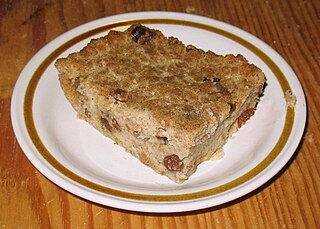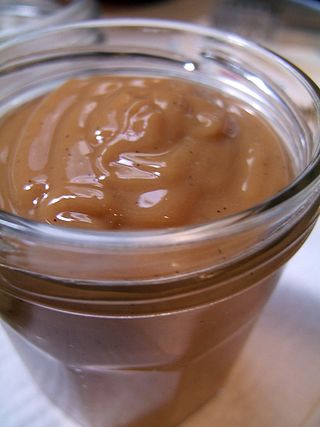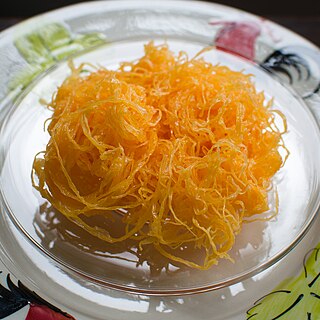
Dessert is a course that concludes a meal. The course consists of sweet foods, such as candy, and possibly a beverage such as dessert wine and liqueur. Some cultures sweeten foods that are more commonly savory to create desserts. In some parts of the world there is no tradition of a dessert course to conclude a meal.

Bread pudding is a bread-based dessert popular in many countries' cuisines. It is made with stale bread and milk or cream, generally containing eggs, a form of fat such as oil, butter or suet and, depending on whether the pudding is sweet or savory, a variety of other ingredients. Sweet bread puddings may use sugar, syrup, honey, dried fruit, nuts, as well as spices such as cinnamon, nutmeg, mace, or vanilla. The bread is soaked in the liquids, mixed with the other ingredients, and baked.

Brazilian cuisine is the set of cooking practices and traditions of Brazil, and is characterized by European, Amerindian, African, and Asian influences. It varies greatly by region, reflecting the country's mix of native and immigrant populations, and its continental size as well. This has created a national cuisine marked by the preservation of regional differences.

Shortcake generally refers to a dessert with a crumbly scone-like texture. There are multiple variations of shortcake, most of which are served with fruit and cream. One of the most popular is strawberry shortcake, which is typically served with whipped cream. Other variations common in the UK are blackberry and clotted cream shortcake and lemon berry shortcake, which is served with lemon curd in place of cream.

Dulce de leche, also known as caramelized milk, milk candy or milk jam in English, is a confection popular in Latin America prepared by slowly heating sugar and milk over a period of several hours. The resulting substance, which takes on a spreadable, sauce-like consistency, derives its rich flavour and colour from non-enzymatic browning. It is typically used to top or fill other sweet foods.

A Swiss roll, jelly roll, roll cake, cream roll, roulade or Swiss log is a type of rolled sponge cake filled with whipped cream, jam, or icing. The origins of the term are unclear; in spite of the name "Swiss roll", the cake is believed to have originated elsewhere in Central Europe, possibly Austria or Slovenia. It appears to have been invented in the nineteenth century, along with Battenberg cake, doughnuts, and Victoria sponge. In the U.S., commercial snack-sized versions of the cake are sold with the brand names Ho Hos, Yodels, Swiss Cake Rolls, and others. A type of roll cake called Yule log is traditionally served at Christmas.

A rice cake may be any kind of food item made from rice that has been shaped, condensed, or otherwise combined into a single object. A wide variety of rice cakes exist in many different cultures in which rice is eaten and are particularly prevalent in Korea and Japan. Common variations include cakes made with rice flour, those made from ground rice, and those made from whole grains of rice compressed together or combined with some other binding substance.

Goiabada ([goja'badɐ]; from goiaba, guava is a conserve made of red guavas and sugar, commonly found throughout the Portuguese-speaking countries of the world. It dates back to the colonial times of Brazil, where guavas were used as a substitute for the quinces used to make marmelada. An abundance of sugar and slave labour were crucial for its confection, in large cauldrons cooking over a slow fire. In rural areas of Brazil, it is still commonly made at home for family use or by home industry outlets or as processed food. It is a deep slightly bluish red colour, sometimes a very dark hue of red.

Dominican cuisine is made up of Spanish, indigenous Taíno, Middle Eastern and African influences. The most recent influences in Dominican cuisine are from the British West Indies and China.

Knafeh is a traditional dessert of Fatimid origin, made with spun pastry called kataifi, soaked in a sweet, sugar-based syrup called attar, and typically layered with cheese, or with other ingredients such as clotted cream, pistachio or nuts, depending on the region. It is popular in the Middle East. Variants are also found in Turkey.

Goan Catholic Cuisine is the cuisine of the Goan Catholic community and is largely influenced by the Saraswat, Konkani, Portuguese, South Indian, and British cuisines. Due to over 450 years of Portuguese rule, the cuisine of Goan Catholics is dominated by ingredients and techniques of Portuguese cuisine like deep-frying, oven-baking, pork, vinegar, egg-based desserts, alcohol, etc.

Fios de ovos is a traditional Portuguese sweet food made of eggs, drawn into thin strands and boiled in sugar syrup. They can be found in Thai dessert and been traditional dish since 16th centuries, around 1679. They are a traditional element in Portuguese and Brazilian cuisine, both in desserts and as side dishes.

Sponge cake is a light cake made with egg whites, flour and sugar, sometimes leavened with baking powder. Some sponge cakes do not contain egg yolks, like angel food cake, but most of them do. Sponge cakes, leavened with beaten eggs, originated during the Renaissance, possibly in Spain. The sponge cake is thought to be one of the first of the non-yeasted cakes, and the earliest attested sponge cake recipe in English is found in a book by the English poet Gervase Markham, The English Huswife, Containing the Inward and Outward Virtues Which Ought to Be in a Complete Woman (1615). Still, the cake was much more like a cracker: thin and crispy. Sponge cakes became the cake recognized today when bakers started using beaten eggs as a rising agent in the mid-18th century. The Victorian creation of baking powder by English food manufacturer Alfred Bird in 1843 allowed the addition of butter to the traditional sponge recipe, resulting in the creation of the Victoria sponge. Cakes are available in many flavours and have many recipes as well. Sponge cakes have become snack cakes via the Twinkie.

Bua loi or bua loy is a Thai dessert. It consists of rice flour rolled into small balls, and cooked in coconut milk and sugar. Some Bua loi also adds sweet egg into the recipe. It was inspired by Tangyuan, a Chinese dessert that is traditionally eaten around the Lantern festival. Bua Loi also traditionally eats at the Dongzhi Festival in Thailand, which is festival for the Chinese-Thai bloodline. There are a variety of versions of Bua loi such as using food coloring instead of natural color, using soy milk instead of Coconut cream, sliced Pumpkin to add inside rice balls, et cetera. There's other type of Bua loi in other country from China, Japan, Indonesia, Myanmar, Philippines, and Southern Vietnam. 1 cup of Bua Loy has total calories of 295.5 kilocalories, protein of 10.4 grams, carbohydrate of 6.3 grams, and fat of 25 grams.
The sixth season of The Great Canadian Baking Show premiered on CBC Television on October 2, 2022. As with previous seasons, ten amateur bakers will compete over eight weeks of challenges, vying for the title. Ann Pornel and Alan Shane Lewis return for their third season as hosts. Bruno Feldeisen and Kyla Kennaley return for their sixth and fourth seasons respectively as judges.

Bolo Fiado, or Bolo Folhado, is a Sri Lankan laminated/layer cake. It is made of sweet pastry layers, alternating with a cashew nut, sugar and rose water filling. It has the appearance of a thick Mille-feuille or large Danish pastry.















